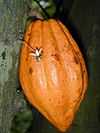Health effects of chocolate

The health effects of chocolate refer to the possible beneficial or detrimental physiological effects of eating chocolate.
Unconstrained consumption of large quantities of any energy-rich food, such as chocolate, without a corresponding increase in activity, increases the risk of obesity. Raw chocolate is high in cocoa butter, a fat removed during chocolate refining, then added back in varying proportions during manufacturing. Manufacturers may add other fats, sugars, and powdered milk as well.
Potential effects in the body
Acne
There is a popular belief that the consumption of chocolate can cause acne. This belief is not supported by scientific studies.[1][2] Various studies point not to chocolate, but to the high glycemic nature of certain foods, like sugar, corn syrup, and other simple carbohydrates, as a cause of acne.[3][4][5][6] Chocolate itself has a low glycemic index.[7] Other dietary causes of acne cannot be excluded yet, but more rigorous research is suggested.[8]
Addiction/craving
There is some evidence that chocolate may be addictive,[9][10] or at least subject to craving; people who crave chocolate or obsessively consume it are referred to as chocoholics.[11]
Aphrodisiac
Romantic lore commonly identifies chocolate as an aphrodisiac. The reputed aphrodisiac qualities of chocolate are most often associated with the simple sensual pleasure of its consumption. Although there is no proof that chocolate is indeed an aphrodisiac , a gift of chocolate is a familiar courtship ritual. Research looking at the psychoactivity of chocolate reveals that methylxanthine, an active biological substance found in chocolate, competes with adenosine, a presynaptic inhibitor modulator, and blocks its receptor.[12] This induced blockage can lead to arousal. The participants' blood pressure decreased, and they showed improvements in insulin sensitivity, meaning they were better able to metabolize glucose.
Cardiovascular system
A 2010 review said that although chocolate has the short-term effect of lowering blood pressure, there is no evidence of any long-term cardiovascular health effect.[13] A 2012 review said that cocoa consumption appears to benefit platelet and vascular function.[14]
Cholesterol
One-third of the fat in chocolate comes from the monounsaturated fat oleic acid, another third from the saturated fat stearic acid, and a third from saturated fat palmitic acid.[15][16] However, unlike other saturated fats, stearic acid does not raise levels of LDL cholesterol in the bloodstream[15] and has neutral effects on cholesterol.[16] Stearic acid can be converted to oleic acid in the liver.[15] Consuming relatively large amounts of dark chocolate and cocoa has not been adequately studied to determine if serum LDL cholesterol levels are altered.[17] In one study, small but regular amounts of dark chocolate were associated with a lower risk of a heart attack.[18]
Stimulant
Chocolate contains a variety of substances, some of which may have an effect on body chemistry. These include:
- Anandamide
- Arginine
- Caffeine and other methylated xanthines (theobromine and theophylline)[19][20]
- Oxalic acid
- Phenethylamine, an endogenous alkaloid sometimes described as a 'love chemical;[21] it is quickly metabolized by monoamine oxidase-B and does not reach the brain in significant amounts
- Phenylalanine
- Phytates
- Sugar
- Tannin
- Tryptophan, an essential amino acid and precursor to serotonin
- Tyramine, found in processed chocolate (not raw cacao) after fermentation.
Chocolate may act as a mild stimulant to humans mainly due to the presence of theobromine and small amounts of caffeine.[22] It is much more potent for horses, and its use in horse racing is prohibited.
White chocolate contains only trace amounts of the caffeine and theobromine of normal chocolates, because these chemicals are contained in the cocoa solids, not the cocoa butter, from which white chocolate is made.
Weight gain
A concern that nutritionists have is that excessive consumption of dark chocolate may promote weight gain and obesity which are risk factors for many diseases, including cardiovascular disease. As a consequence, consuming large quantities of dark chocolate in an attempt to protect against cardiovascular disease has been described as 'cutting off one's nose to spite one's face'.[23]
Lead content
Chocolate consumption may have potential to cause mild lead poisoning, as some studies have shown that lead may bind to cocoa shells and contamination may occur during the manufacturing process.[24] In a USDA study in 2004, mean lead levels in the samples tested ranged from 0.0010 to 0.0965 µg lead per gram of chocolate, but another study by a Swiss research group in 2002 found that some chocolate contained up to 0.769 µg per gram, close to the international (voluntary) standard limit for lead in cocoa powder or beans, which is 1 µg of lead per gram.[25] In 2006, the U. S. FDA lowered by one-fifth the amount of lead permissible in candy, but compliance is only voluntary.[26]
Polyphenol content
Chocolate contains polyphenols, especially flavan-3-ols (catechins) and flavonoids which are under study for their potential effects in the body. The following table shows the phenolic and flavonoid content of three different types of chocolate.[27]
| Type of chocolate | Total phenolics (mg/100g) | Flavonoids (mg/100g) |
|---|---|---|
| Dark chocolate | 579 | 28 |
| Milk chocolate | 160 | 13 |
| White chocolate | 126 | 8 |
Potential toxicity in animals
In sufficient amounts, the theobromine found in chocolate is toxic to animals such as cats, dogs, horses, parrots, and small rodents because they are unable to metabolise the chemical effectively.[28] If animals are fed chocolate, the theobromine may remain in the circulation for up to 20 hours, possibly causing epileptic seizures, heart attacks, internal bleeding, and eventually death. Medical treatment performed by a veterinarian involves inducing vomiting within two hours of ingestion and administration of benzodiazepines or barbiturates for seizures, antiarrhythmics for heart arrhythmias, and fluid diuresis.
A typical 20-kilogram (44 lb) dog will normally experience great intestinal distress after eating less than 240 grams (8.5 oz) of dark chocolate, but will not necessarily experience bradycardia or tachycardia unless it eats at least a half a kilogram (1.1 lb) of milk chocolate. Dark chocolate has 2 to 5 times more theobromine and thus is more dangerous to dogs. According to the Merck Veterinary Manual, approximately 1.3 grams of baker's chocolate per kilogram of a dog's body weight (0.02 oz/lb) is sufficient to cause symptoms of toxicity. For example, a typical 25-gram (0.88 oz) baker's chocolate bar would be enough to bring about symptoms in a 20-kilogram (44 lb) dog. Of course, baking chocolate is rarely consumed directly due to its unpleasant taste, but other dark chocolates' canine toxicities may be extrapolated based on this figure. Given access, dogs frequently consume chocolate at toxic levels because they like the taste of chocolate products and are capable of finding and eating quantities much larger than typical human servings. There are reports that mulch made from cacao bean shells is dangerous to dogs and livestock.[29][30][31]
References
- ↑ Karl S. Kruszelnicki (8 June 2004). "Chocolate-Flavoured Acne". ABC Science. Australian Broadcasting Corporation.
- ↑ Leah L. Porter (June 2006). "Benefits of Cocoa Polyphenols". The Manufacturing Confectioner. p. 52.
- ↑ Smith RN, Mann NJ, Braue A, Mäkeläinen H, Varigos GA (July 2007). "A low-glycemic-load diet improves symptoms in acne vulgaris patients: a randomized controlled trial". The American Journal of Clinical Nutrition 86 (1): 107–15. PMID 17616769.
- ↑ Anahad O’Connor (23 February 2009). "The Claim: Sugar in the Diet Can Lead to Acne". New York Times.
- ↑ "Chocolate" (http://www.betterhealth.vic.gov.au/bhcv2/bhcarticles. nsf/(Pages)/Chocolate?OpenDocument). Better Health Channel. Retrieved 3 April 2009.
- ↑ Cordain, L; Lindeberg, S; Hurtado, M; Hill, K; Eaton, SB; Brand-Miller, J (December 2002). "Acne vulgaris: a disease of Western civilization". Archives of Dermatology 138 (12): 1584–1590. doi:10.1001/archderm.138.12.1584. PMID 12472346.
- ↑ "Sweet News for Managing Blood Sugar.". allchocolate.com. Retrieved 3 April 2009.
- ↑ Magin P, Pond D, Smith W, Watson A (February 2005). "A systematic review of the evidence for 'myths and misconceptions' in acne management: diet, face-washing and sunlight". Family Practice 22 (1): 62–70. doi:10.1093/fampra/cmh715. PMID 15644386.
- ↑ Miller, Michael Craig (14 February 2013). "Can you become addicted to chocolate?". Harvard Health Blog. Harvard University. Retrieved 14 April 2013.
- ↑ "Chocoholic? Now for the science part". Wales Online. April 18, 2006. Retrieved 14 April 2013.
- ↑ Skarnulis, Leanna. "The Chocoholic's Survival Guide". webmd.com. Retrieved 14 April 2013.
- ↑ Nehlig, A., Daval, J., and Debry, G. (1992). "Caffeine and the central nervous system: mechanisms of action, biochemical, metabolic, and psychostimulant effects". Brain Research Reviews 17 (2): 139–170. doi:10.1016/0165-0173(92)90012-B. PMID 1356551.
- ↑ Milliron T, Kelsberg G, St Anna L (June 2010). "Clinical inquiries. Does chocolate have cardiovascular benefits?" (PDF). J Fam Pract (Review) 59 (6): 351–2. PMID 20544068.
- ↑ Sudano I, Flammer AJ, Roas S, et al. (August 2012). "Cocoa, blood pressure, and vascular function". Curr. Hypertens. Rep. (Review) 14 (4): 279–84. doi:10.1007/s11906-012-0281-8. PMID 22684995.
In the last ten years many research studies confirmed that cocoa does indeed exert beneficial effects on vascular and platelet function.
- ↑ 15.0 15.1 15.2 "Chocolate: Food of the Gods". Yale - New Haven Hospital. Retrieved 4 September 2010.
- ↑ 16.0 16.1 "Heart-Health Benefits of Chocolate Unveiled". Cleveland Clinic Miller Family Heart & Vascular Institute (update February 2010). Retrieved 4 September 2010.
- ↑ Kondo, K; Hirano, R; Matsumoto, A; Igarashi, O; Itakura, H. (1996). "Inhibition of LDL oxidation by cocoa". Lancet 348 (9040): 1514. doi:10.1016/S0140-6736(05)65927-2. PMID 8942794.
- ↑ Ross, Emma (30 August 2004). "Dark Chocolate Could Help Hearts". CBS News. Retrieved 29 May 2008.
- ↑ Matissek, Reinhard (1997). "Evaluation of xanthine derivatives in chocolate - nutritional and chemical aspects". Zeitschrift für Lebensmitteluntersuchung und -Forschung A 205 (3): 175–184. doi:10.1007/s002170050148.
- ↑ Verna, R (2013). "The history and science of chocolate". The Malaysian journal of pathology 35 (2): 111–21. PMID 24362474.
- ↑ Liebowitz, Michael R. (1983). The chemistry of love. Boston: Little, Brown. ISBN 0-316-52430-1.
- ↑ Smit HJ, Gaffan EA, Rogers PJ (November 2004). "Methylxanthines are the psycho-pharmacologically active constituents of chocolate". Psychopharmacology 176 (3–4): 412–419. doi:10.1007/s00213-004-1898-3. PMID 15549276.
- ↑ Adams, Stuart J. "A Critical Look at the Effects of Cocoa on Human Health.". Pabulum, 2004 Issue 61. Retrieved 3 March 2006.
- ↑ Rankin, CW; Nriagu, JO; Aggarwal, JK; Arowolo, TA; Adebayo, K; Flegal, AR (October 2005). "Lead contamination in cocoa and cocoa products: isotopic evidence of global contamination". Environmental Health Perspectives 113 (10): 1344–1348. doi:10.1289/ehp.8009. PMC 1281277. PMID 16203244.
- ↑ Karrie Heneman & Sheri Zidenberg-Cherr (2006). "Is Lead Toxicity Still a Risk to U. S. Children?". California Agriculture 60 (4). Retrieved 15 February 2007.
- ↑ Lorraine Heller (29 November 2006). "FDA issues new guidance on lead in candy". FoodNavigator.com. Retrieved 15 February 2007.
- ↑ Meng CC, Jalil AM, Ismail A (2009). "Phenolic and theobromine contents of commercial dark, milk and white chocolates on the Malaysian market". Molecules 14 (1): 200–9. doi:10.3390/molecules14010200. PMID 19127248.
- ↑ Smit HJ (2011). "Theobromine and the pharmacology of cocoa". Handb Exp Pharmacol 200 (200): 201–34. doi:10.1007/978-3-642-13443-2_7. PMID 20859797.
- ↑ "Chocolate with Animals". Animal Poison Control Center. Retrieved 17 May 2008.
- ↑ Drolet R, Arendt TD, Stowe CM. Cacao bean shell poisoning in a dog. JAVMA 1984;185(8): 902.
- ↑ Blakemore F, Shearer GD. The poisoning of livestock by cacao products. Vet Record 1943;55(15).
| ||||||||||||||||||||||||||||||||||||
| ||||||||||||||||||
